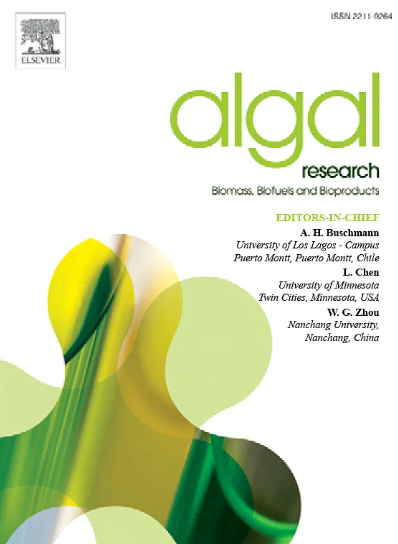Tailored illumination augmenting growth and phycocyanin production by Spirulina platensis: A mixture design approach
IF 4.6
2区 生物学
Q1 BIOTECHNOLOGY & APPLIED MICROBIOLOGY
Algal Research-Biomass Biofuels and Bioproducts
Pub Date : 2025-06-07
DOI:10.1016/j.algal.2025.104129
引用次数: 0
Abstract
To enhance biomass and pigments production by Spirulina platensis, a cyanobacterium known for its high phycocyanin formation, monochromatic (100), balanced (50–50) and disproportionate (70–30) dichromatic lightings of red (R), white (W) and blue (B) were examined in a 1-L glass photobioreactor. Preliminary experiments showed the positive effect of monochromatic light intensity (50, 100 and 200 μmol/m2.s) on growth, with the highest biomass (3.95 g/L) belonging to red at intensity of 200 μmol/m2.s. A simplex mixture design was subsequently applied to investigate biomass, phycocyanin, chlorophyll a and carotenoids concentrations as well as nutrients removal under the designed lightings at total intensity of 200 μmol/m2.s over 30 days. The highest concentration of biomass (8.8 g/L), phycocyanin (1.41 mg/mL), chlorophyll a (0.118 mg/mL), and carotenoids (0.0345 mg/mL) corresponded to dichromatic red and blue lighting (70R-30B), showing that a small proportion of blue light alongside red is crucial for enhancing both growth and pigments production. Although the lowest concentrations belonged to monochromatic blue, phycocyanin content and nutrients (nitrate and phosphate) uptake yields on biomass were the highest for this strategy, showing the adverse effect of decreasing blue in dichromatic red and blue lighting on the overall pigments content of cell. This phenomenon can be attributed to the high photon energy of blue light, which induces cellular stress and subsequently triggers an upregulation of phycocyanin biosynthesis as a protective response. Since cultivation at industrial-scale requires the highest pigments productivity rather than cell contents of pigments, 70R-30B proved itself as the most economical strategy.

量身定制的照明促进螺旋藻生长和藻蓝蛋白生产:一种混合设计方法
为了提高螺旋藻(Spirulina platensis)的生物量和色素产量,一种以其高藻蓝蛋白形成而闻名的蓝藻,在1-L玻璃光生物反应器中检测了单色(100),平衡(50-50)和不比例(70-30)的红(R),白(W)和蓝(B)的二色光照。初步实验表明,单色光强度(50、100和200 μmol/m2.s)对生长有积极影响,200 μmol/m2.s单色光强度下,赤色生物量最高,为3.95 g/L。在设计的总光照强度为200 μmol/m2的光照条件下,采用单形混合设计研究了生物量、藻蓝蛋白、叶绿素A和类胡萝卜素浓度以及营养物去除率。超过30天。最高浓度的生物量(8.8 g/L)、藻蓝蛋白(1.41 mg/mL)、叶绿素a (0.118 mg/mL)和类胡萝卜素(0.0345 mg/mL)对应于二色性的红色和蓝色照明(70R-30B),表明少量蓝光和红光对促进生长和色素生成至关重要。虽然单色蓝浓度最低,但藻蓝蛋白含量和营养物质(硝酸盐和磷酸盐)对生物量的吸收产量最高,这表明在二色红和蓝色照明下减少蓝色对细胞整体色素含量的不利影响。这种现象可归因于蓝光的高光子能量,它诱导细胞应激,随后引发藻蓝蛋白生物合成的上调,作为一种保护反应。由于工业规模的培养需要最高的色素产量,而不是色素的细胞含量,70R-30B被证明是最经济的策略。
本文章由计算机程序翻译,如有差异,请以英文原文为准。
求助全文
约1分钟内获得全文
求助全文
来源期刊

Algal Research-Biomass Biofuels and Bioproducts
BIOTECHNOLOGY & APPLIED MICROBIOLOGY-
CiteScore
9.40
自引率
7.80%
发文量
332
期刊介绍:
Algal Research is an international phycology journal covering all areas of emerging technologies in algae biology, biomass production, cultivation, harvesting, extraction, bioproducts, biorefinery, engineering, and econometrics. Algae is defined to include cyanobacteria, microalgae, and protists and symbionts of interest in biotechnology. The journal publishes original research and reviews for the following scope: algal biology, including but not exclusive to: phylogeny, biodiversity, molecular traits, metabolic regulation, and genetic engineering, algal cultivation, e.g. phototrophic systems, heterotrophic systems, and mixotrophic systems, algal harvesting and extraction systems, biotechnology to convert algal biomass and components into biofuels and bioproducts, e.g., nutraceuticals, pharmaceuticals, animal feed, plastics, etc. algal products and their economic assessment
 求助内容:
求助内容: 应助结果提醒方式:
应助结果提醒方式:


